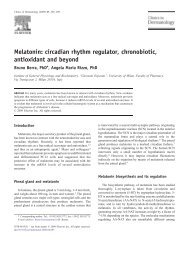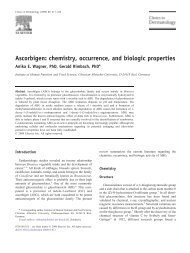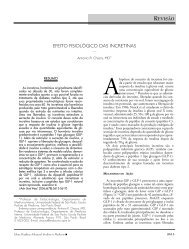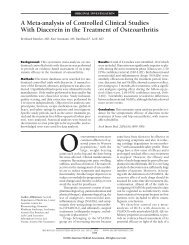Nutrition and skin. Collagen integrity: a dominant role for amino acids
Nutrition and skin. Collagen integrity: a dominant role for amino acids
Nutrition and skin. Collagen integrity: a dominant role for amino acids
Create successful ePaper yourself
Turn your PDF publications into a flip-book with our unique Google optimized e-Paper software.
Clinics in Dermatology (2008) 26, 636–640<strong>Nutrition</strong> <strong>and</strong> <strong>skin</strong>. <strong>Collagen</strong> <strong>integrity</strong>: a <strong>dominant</strong> <strong>role</strong> <strong>for</strong><strong>amino</strong> <strong>acids</strong>Francesco Saverio Dioguardi, MDDepartment of Internal Medicine, University of Milan, 20122 Milan, ItalyAbstract The <strong>skin</strong> is an important organ, <strong>and</strong> the need <strong>for</strong> attention to its metabolic requirements is oftenunderestimated by professionals involved with its <strong>integrity</strong> <strong>and</strong> beauty. Amino <strong>acids</strong> are theindispensable nutritional basis <strong>for</strong> the maintenance of its <strong>integrity</strong>. The <strong>skin</strong> has very peculiar <strong>amino</strong>acid needs, which should be acknowledged <strong>and</strong> supplied if necessary.© 2008 Elsevier Inc. All rights reserved.The <strong>skin</strong> makes up <strong>for</strong> about 8% of an adult's bodyweight, <strong>and</strong> its gross protein content is around 22%,accounting <strong>for</strong> one eighth of the body's total proteins.<strong>Collagen</strong> makes up <strong>for</strong> 70% of the total nitrogen content of<strong>skin</strong> proteins.Because of its tensile strength, this extracellular proteinbears structural stresses either as the connective tissues ofany parenchymal organ (such as liver, kidneys, intestines,lungs, <strong>and</strong> heart) or as the protein matrix of the skeleton <strong>and</strong>its related structures (bone, teeth, cartilage, tendons, <strong>and</strong>ligaments), or it <strong>for</strong>ms the fibrous matrix of the <strong>skin</strong> <strong>and</strong>blood vessels. <strong>Collagen</strong> is there<strong>for</strong>e the most abundantprotein in human body. Its tensile strength <strong>and</strong> flexibility arethe result of a complex molecular structure, itself theconsequence of a well-described peculiarly regular <strong>amino</strong>acidic content.Although there are almost 20 different types of collagen,their composition is fairly similar: from any given 3 <strong>amino</strong><strong>acids</strong>, one is glycine, the smallest of all <strong>amino</strong> <strong>acids</strong>. Therather monotonous composition of collagen peptides is notonly limited to the absolutely regular recurrence of theglycine residue, but this is also accompanied, in thefollowing 2 positions, called positions X <strong>and</strong> Y, by a veryfrequent Y position occupied by hydroxyproline, in up toE-mail address: fsdioguardi@galactica.it.50% of cases, <strong>and</strong> hydroxylysine, in most of the remainingsequences. These <strong>amino</strong> <strong>acids</strong> are typical of collagenstructures <strong>and</strong> are very rarely found in other proteins. Oneof the most interesting characteristic of collagen synthesis isin that either hydroxyproline or hydroxylysine is themetabolic dead end of proline <strong>and</strong> lysine, which means itis possible that they have to be discarded once collagenstructure becomes old <strong>and</strong> needs to be renewed. This is dueto the fact that to obtain maximum physicochemicalper<strong>for</strong>mance, “fresh” proline <strong>and</strong> lysine should be insertedin the newly <strong>for</strong>med propeptide. Only after the synthesis ofthe full precursor chain a specific vitamin C–dependenthydroxylase, acting stereologically (ie, it is activated byparticular parts of the molecule) on the Y position, isactivated to attach them to an \OH moiety. This isfundamental <strong>for</strong> a cascade of events, which allows a Maillardreaction to <strong>for</strong>m tight inter- <strong>and</strong> intramolecular bonds,entangling 3 peptides into fibrils <strong>and</strong> tightening them solidlyinto the complex collagen units.Scurvy clinical presentation, that is, bones, tendons, <strong>skin</strong>,<strong>and</strong> vessel fragility, <strong>and</strong> poor wound healing, is related to theimpaired activity of this enzymatic activity.Glycine positioned among any 3 <strong>amino</strong> <strong>acids</strong> allowsregular bending of the peptide str<strong>and</strong> <strong>and</strong> the <strong>for</strong>mation of aleft-h<strong>and</strong>ed helical structure, intertwined with 2 otherpeptides in a right-h<strong>and</strong>ed superhelical structure, very similar0738-081X/$ – see front matter © 2008 Elsevier Inc. All rights reserved.doi:10.1016/j.clindermatol.2007.09.004
<strong>Nutrition</strong> <strong>and</strong> <strong>skin</strong>to the structure of a rope. The small differences in <strong>amino</strong><strong>acids</strong> driven by the regularity of sequences in any peptideallow to distinguish about 33 genetic variations of them(subunits), <strong>and</strong> the different types of collagen, identified by aRoman numeral, differ in the type of subunits. As a generalexample, the most abundant collagen type, called type I (ie,one), which is present in <strong>skin</strong>, bones, tendon, blood vessels,<strong>and</strong> cornea, has a triple chain composition <strong>for</strong>med by 2 α 1<strong>and</strong> 1 α 2 chains. Elastin also has an extremely regularcomposition of <strong>amino</strong> <strong>acids</strong> but a far greater abundance of aparticular <strong>amino</strong> acid, leucine.Amino <strong>acids</strong> are the “letters” indispensable to the DNAdependent“writing” of proteins. But only carbohydrates (ie,glucose) or lipids (with a noteworthy exception of fewpolyunsaturated fatty <strong>acids</strong>) can be synthesized by the liverby using <strong>amino</strong> <strong>acids</strong>. Conversely, <strong>amino</strong> <strong>acids</strong> cannot beoriginated from carbohydrates or lipids unless certain <strong>amino</strong>acid donors such as \NH 3 (ammonia) are present. Thesepeculiar 10 <strong>amino</strong> <strong>acids</strong> can only be synthesized in extremelysmall amounts, <strong>and</strong> then only locally. These have there<strong>for</strong>ebeen defined “essential” <strong>amino</strong> <strong>acids</strong> <strong>and</strong> should becontinuously introduced with foodstuff in amounts capableof meeting turnover needs. Neither glycine nor proline is anindispensable <strong>amino</strong> acid, <strong>and</strong> they can be synthesized fromother <strong>amino</strong> <strong>acids</strong>, whereas lysine also is an essential one.Another fundamental peculiarity of protein synthesis,common to collagen <strong>and</strong> to any other protein, is that all<strong>amino</strong> <strong>acids</strong> to be found in the final protein should also bepresent inside the cells, at their synthesizing sites, <strong>and</strong> in thecorrect number of molecules.The need of simultaneous availability of all <strong>amino</strong> <strong>acids</strong>(think of them as letters of the alphabet) to “write” aprotein (the “word” you need) is a limiting factor <strong>for</strong> thesynthesis. The availability of <strong>amino</strong> <strong>acids</strong> <strong>for</strong> proteinsynthesis is threatened by their eventual duty in the maintenanceof energy needs, which can consume an unpredictableamount of different <strong>amino</strong> <strong>acids</strong>. Not all <strong>amino</strong><strong>acids</strong> have an equal degree of participation in this fate. 1,2This mechanism may become dramatically relevant in allenergy-dem<strong>and</strong>ing pathological conditions that increaseburden on metabolism. 3,4Indeed, the specific <strong>dominant</strong> <strong>role</strong> of <strong>amino</strong> <strong>acids</strong> as rulersof metabolism requirements springs from the fact that, fromamong the peculiar atoms that make up the mammal body,carbon, oxygen, hydrogen, <strong>and</strong> nitrogen, only the first 3can be introduced with either carbohydrates, lipids, orproteins, whereas nitrogen needs can only be replenished by<strong>amino</strong> <strong>acids</strong>.It is there<strong>for</strong>e important to stress the notion that, without<strong>amino</strong> <strong>acids</strong>, no protein synthesis can take place, <strong>and</strong> whenno synthesis is possible, the first metabolic reaction is toreduce catabolism to maintain the <strong>integrity</strong> of the complexprotein machinery of cells <strong>and</strong> tissues. Although thisinhibitory process is activated <strong>for</strong> survival purposes, itcauses a general aging of proteins, which become older <strong>and</strong>older <strong>and</strong> eventually lose their efficiency, whether they are637contractile, structural (ie, collagens), enzymatic, or defensive(ie, antibodies) proteins.The <strong>role</strong> of the stoichiometric ratios of special <strong>for</strong>mulationof <strong>amino</strong> <strong>acids</strong> in the control of anabolic/catabolic ratios, <strong>and</strong>in the drive entry of carbohydrates or lipid-derived metabolicintermediates, has been recently detailed 5 <strong>and</strong> proved to beeffective in reversing insulin resistance <strong>and</strong> malnutrition inpatients with type 2 diabetes affected by chronic heart failure<strong>and</strong> in protecting against ischemia reperfusion injury. 6,7We should not be surprised, at this point, at the resultsreported by a recent r<strong>and</strong>omized, prospective, controlled,multicentric study, which observed a twice-increased rate ofpressure ulcer healing in the group treated with collagenprotein hydrolysate supplement, when compared with thegroup that received the same st<strong>and</strong>ard wound care plusplacebo. 8 On the contrary, in a previous study, topicalcollagen <strong>and</strong> hydrocolloid dressings did not show significantdifferences in healing outcome. 9 There is no contradiction inthose studies: the oral route allows a more elevated <strong>amino</strong>acid supplementation to the dermis <strong>and</strong>, consequently, amore abundant supply of appropriately not hydroxylatedproline <strong>and</strong> lysine to dermis fibroblasts. It seems likely thatan excessive presence of <strong>amino</strong> <strong>acids</strong> at the dead end of theirmetabolic flows (we are speaking of hydroxyproline <strong>and</strong>hydroxylysine) impairs, <strong>and</strong> not promotes, any syntheticimprovement topically. On the contrary, flooding plasmawith a concentrated <strong>and</strong> <strong>for</strong>tified supplement should providea far better amount of hydroxylated lysine <strong>and</strong> proline,effectively promoting immediate synthesis improvement ofprocollagen assembly <strong>and</strong> hydroxylation be<strong>for</strong>e secretion.On these bases, one would be tempted to hypothesize anabundant choice of articles dealing with correct nitrogenintake <strong>for</strong> the maintenance of <strong>skin</strong> youth, <strong>and</strong> deeplydiscussing <strong>amino</strong> <strong>acids</strong> in terms of <strong>skin</strong> nutrition, or dealingwith the antiaging properties of selected <strong>amino</strong> acid<strong>for</strong>mulations suitable to promote <strong>skin</strong> <strong>integrity</strong> <strong>and</strong> beauty.This is wrong.A PubMed search (http://www.ncbi.nlm.nih.gov) on“nutrition influence on dermis” results in just 2 articles,dated 1994 <strong>and</strong> 2005, one of them dealing with therelationships between serum cholesterol <strong>and</strong> <strong>skin</strong> cholesterolsynthesis in humans, 10 the other studying the relationshipbetween diet <strong>and</strong> <strong>skin</strong> in the aging rat. 11 This latter isinteresting because it shows that aging <strong>and</strong> malnutritionreduce the thickness <strong>and</strong> depth of epidermis <strong>and</strong> dermis, witha cumulative effect if aging <strong>and</strong> malnutrition were present inthe examined population.A “nutrition <strong>and</strong> <strong>skin</strong>” search gives back 4530 articles,with 142 references published in 2005. Twenty-eight articlesdealt with <strong>skin</strong>-fold measurement or hair or body composition<strong>and</strong> nutritional habits or malnutrition; 25 articlesexamined the possible pathogenic <strong>role</strong> of vitamins (12articles, most about vitamin D) <strong>and</strong>/or micronutrientdeficiency or introduction. 12 In 12 articles, <strong>skin</strong> lesions <strong>and</strong>wound care were related to peculiar pathological conditions.13,14 Food <strong>and</strong> experimental or veterinarian reports
638 F.S. Dioguardiwere studied by 26 articles, food <strong>and</strong> allergies were studiedby 14 reports, 25 articles studied obstetric or neonatalpathological conditions or nutritional deficiencies, 15,16 <strong>and</strong>6 dealt with clinical dermatologic conditions. 17 One articlewas a letter about the definition <strong>and</strong> possible future ofnutrigenomics, using as an example the knowledge aboutgenetic control of the enzyme critical <strong>for</strong> folate regenerationmethyltetrahydrofolate reductase, 18 <strong>and</strong> one was about selfperceptionof technical skills by nurses.In this group, we were able to identify only four articlesthat generically assessed the malnutrition/<strong>skin</strong> relationship,two dealing with selective nutritional deficiencies <strong>and</strong> <strong>skin</strong> ininternal medicine patients (pellagra <strong>and</strong> vitamin B 12deficiencies in two malnourished patients, 19 essential fatty<strong>acids</strong> <strong>and</strong> vitamins 20 ), another with the identification ofserum amyloid A production by white adipocyte <strong>and</strong> its dietregulation, 21 <strong>and</strong> a fourth observed the negative incidence ofprotein-energy malnutrition effects on infection rate, healing,<strong>and</strong> mortality in elderly burn patients. 22 The search engine ofthe American Journal of Clinical <strong>Nutrition</strong> showed 26entries when asked <strong>for</strong> “<strong>skin</strong>,” 11 of which studiedsubcutaneous fat thickness evaluation <strong>and</strong> significance indifferent pathological conditions, 23-33 2 dealt mostly withessential fatty <strong>acids</strong> metabolism <strong>and</strong> <strong>skin</strong>, 34,35 9 were aboutvitamins (mostly vitamins D <strong>and</strong> E), 36-42 <strong>and</strong> 6 specificallystudied protein nutrition <strong>and</strong> dermis.Two were published in 1970 by the same author <strong>and</strong>reported alterations of proteins <strong>and</strong> <strong>amino</strong> acidic content inplasma <strong>and</strong> <strong>skin</strong> of kwashiorkor patients, 43 <strong>and</strong> the effects ofexperimental protein deficiency on <strong>skin</strong> weight. 2One was published in 1975 <strong>and</strong> studied the ratio betweenurinary <strong>and</strong> sweat nitrogen losses. 44In 2001, 2 articles were published about wrinkling <strong>and</strong>aging <strong>skin</strong>, focusing on the <strong>role</strong> of dietary fatty <strong>acids</strong> <strong>and</strong>micronutrients. 34,35 One of the same authors published afurther study 45 in 2003, reporting noninvasive biophysicalmethods to assess <strong>skin</strong> variables such as hydration,surface pH, <strong>and</strong> sebum content in a population studied <strong>for</strong>its food intake.Two different semiquantitative <strong>and</strong> qualitative foodfrequencyquestionnaires recorded 3 months of introductionof macronutrients <strong>and</strong> fibers, <strong>and</strong> of micronutrients <strong>and</strong> fluid,in an attempt to find possible associations with <strong>skin</strong>conditions noninvasively evaluated.Conversely, a very satisfactory series of articles isobtained by searching <strong>for</strong> “malnutrition <strong>and</strong> wound healing,”which I believe is the right choice. Fifty detailed nutritionrequirement articles were found in October 2006, starting thesearch from December 2003, among a total of 433 articles. In2006, several excellent articles were published, which maybe worthy of dermatologists' attention, even those notparticularly interested in developing advanced knowledge inwound care.Reviews were 19, none with a free full text option, <strong>and</strong>many did not even have abstracts. Eight articles have beenpublished on the same newspaper (Advanced Skin <strong>and</strong>Wound Care), whereas the others have been published on 36different magazines. Two articles are in other languages thanEnglish (French <strong>and</strong> Spanish). If you wish to invest in justone article, I suggest the excellent “Practical aspects ofnutritional support <strong>for</strong> wound-healing patients,” publishedon the American Journal of Surgery, 46 because it gives awide <strong>and</strong> wise overview of the many aspects of woundhealing related to nutritional problems <strong>and</strong> of the possiblesolutions, with a very professional but practical <strong>and</strong> easy-tounderst<strong>and</strong>approach to the most advanced managementtechniques. I also recommend either “<strong>Nutrition</strong>al considerationsin wound care” 47 or “Do malnutrition <strong>and</strong> nutritionalsupplementation have an effect on the wound healingprocess?,” 48 which would be appreciated by either thescientifically advanced or the most empirical reader. Anintriguing article should attract physicians mostly involvedin prevention, “<strong>Nutrition</strong>al status <strong>and</strong> food intake in ninepatients with chronic low-limb ulcers <strong>and</strong> pressure ulcers:importance of oral supplements,” which reported highfrequency of micronutrient deficits <strong>and</strong> protein-caloriesmalnutrition in a small group (nine patients) of peopleaged 71 ± 10 years be<strong>for</strong>e <strong>and</strong> after surgery. 49 This articlereminds us that most dermatological problems could beprevented not with topical therapies, but with a more carefulapproach to general metabolism requirements. In case ofdoubts about a peculiar patient, the advice of a specialist ininternal medicine <strong>and</strong> clinical nutrition is priceless.A must do as the very first easy-to-read <strong>and</strong> mostsynthetic (sometimes excessively so) document, there<strong>for</strong>eunsatisfactory <strong>for</strong> most professionals, could be found atthe “National Pressure Ulcer Advisory Panel. Frequentlyasked questions” Internet address. Available at http://www.npuap.org.There is still a long way to go be<strong>for</strong>e nutritional skills <strong>and</strong><strong>skin</strong> are linked <strong>and</strong> promoted correctly.Therapeutic boxA major claim of most cosmetic treatments is theefficiency in <strong>skin</strong> nutrition. To date, basing on marketingattractive claims, many different molecules or mixtures ofvitamins, salts, <strong>and</strong> vegetable extracts have been put on themarket, although with unpredictable efficiency.Amino <strong>acids</strong> are unique molecules because they are theonly substrate really necessary <strong>for</strong> promoting the synthesis ofany protein. The adequacy of type <strong>and</strong> number of <strong>amino</strong><strong>acids</strong> required <strong>for</strong> protein synthesis can be predicted on thebasis of the quality <strong>and</strong> quantity of <strong>amino</strong> <strong>acids</strong> present ineach protein. But collagen synthesis is different becausesome of its <strong>amino</strong> <strong>acids</strong> should be provided in the precursor<strong>for</strong>m to activate the synthetic drive by fibroblasts. <strong>Collagen</strong>synthesis is, there<strong>for</strong>e, efficiently maintained only whenthose specific <strong>amino</strong> <strong>acids</strong> are continuously available <strong>and</strong> arepresent in a specific ratio.
<strong>Nutrition</strong> <strong>and</strong> <strong>skin</strong>A functional cluster of <strong>amino</strong> <strong>acids</strong> that is suitable <strong>for</strong>collagen synthesis promotion is protected by patents (eg,US patent no. 5198465) <strong>and</strong> is widely available in Europein the <strong>for</strong>m of a topical cosmetic, as well as a medicaldevice, <strong>for</strong> the treatment of localized <strong>skin</strong> damages (bedsores, diabetic foot, etc). It is also available <strong>for</strong> intradermalinjections (commercial name, Jalu-Pro). Indeed, the localinjection of this <strong>for</strong>mulation may be a potent tool in skilledh<strong>and</strong>s because it is known that chemotaxis is the strongest<strong>for</strong>ce in nature that drives life: living beings are attractedby food. When we fill the dermis injecting the proper<strong>amino</strong> acid <strong>for</strong>mulation, we send a very strong biologicmessage to fibroblasts. The choice of the injection siteallows the physician to drive fibroblasts to the target sitewhere the promotion of the synthesis of integral dermis isdesired, such as in fibrotic tissue nodules, wrinkles, orstretches. Feeding fibroblasts with the right food (ie, theright <strong>amino</strong> <strong>acids</strong> <strong>for</strong>mulation) means also promotinggrowth factors production, thus, activating all thosecomplex balances of the catabolic-anabolic pathways thatrestore a normal structure of dermal architecture. Synthetically,the zonation of the chemotactic stimulus, aiming atfunctionally driving the collagen synthesis induced by theright cluster of <strong>amino</strong> <strong>acids</strong>, elicits maximal trophism <strong>and</strong>physiologic rejuvenation of collagen structure at theinjection site. By now, there is no chance to find this<strong>for</strong>mulation in the United States, either as topical treatmentor as medical device <strong>for</strong> injections.References1. Millward DJ. Macronutrients intakes as determinants of dietary protein<strong>and</strong> <strong>amino</strong> acid adequacy. J Nutr 2004;134:1588S-96S.2. Vasanhta L, Srikantia SG, Gopalan G. Biochemical changes in the <strong>skin</strong>in kwashiorkor. Am J Clin Nutr 1970;23:78-82.3. Baracos VE. Cancer-associated cachexia <strong>and</strong> underlying mechanisms.Annu Rev Nutr 2006;26:13.1-13.27.4. Millward DJ, Bowtell JL, Pacy P, et al. Physical activity, proteinmetabolism <strong>and</strong> protein requirements. Proc Nutr Soc 1994;53:223-40.5. Dioguardi FS. Wasting <strong>and</strong> the substrate-to-energy controlled pathway:a <strong>role</strong> <strong>for</strong> insulin resistance <strong>and</strong> <strong>amino</strong> <strong>acids</strong>. Am J Cardiol 2004;93(supplement):6A-12A.6. Scognamiglio R, Negut C, Piccolotto R, et al. Effects of oral <strong>amino</strong> <strong>acids</strong>upplementation on myocardial function in patients with type 2 diabetesmellitus. Am Heart J 2004;147:1106-12.7. Scarabelli TM, Pasini E, Stephanou A, et al. <strong>Nutrition</strong>al supplementationwith mixed essential <strong>amino</strong> <strong>acids</strong> enhances myocyte survival,preserving mitochondrial functional capacity during ischemia-reperfusioninjury. Am J Cardiol 2004;93:35A-40A.8. Lee SK, Posthauer ME, Dorner B, Redovian V, Maloney MJ. Pressureulcer healing with a concentrated, <strong>for</strong>tified, collagen protein hydrolysatesupplement: a r<strong>and</strong>omized controlled trial. Adv Skin Wound Care 2006;19:92-6.9. Graumich JF, Blough LS, McLaughlin RG, et al. Healing pressureulcers with collagen or hydrocolloid: a r<strong>and</strong>omized, controlled trial. AmGeriatr Soc 2003;51:147-54.10. Thomas JR. Effects of age <strong>and</strong> diet on rat <strong>skin</strong> histology. Laryngoscope2005;115:405-11.63911. Wu-Pong S, Elias PM, Feingold KR. Influence of altered serumcholesterol levels <strong>and</strong> fasting on cutaneous cholesterol synthesis.J Invest Dermatol 1994;102:799-802.12. McNaughton SA, Marks GC, Green AC. Role of dietary factors in thedevelopment of basal cell cancer <strong>and</strong> squamous cell cancer of the <strong>skin</strong>.Cancer Epidemiol Biomarkers Prev 2005;14:1596-607.13. Firth J. Risk assessment of <strong>skin</strong> in rheumatic disease. Nurs Times 2005;101:54-5.14. Wolfwolff H, Hansson C. Rearing larvae of Lucilia sericata <strong>for</strong> chroniculcer treatment—an improved method. Acta Derm Venereol 2005;85:129-40.15. Morrill JF, Heinig MJ, Pappagianis D, et al. Risk factors <strong>for</strong> mammaryc<strong>and</strong>idosis among lactating women. J Obstet Gynecol Neonatal Nurs2005;34:37-45.16. Sipetic S, Vlajinac H, Kocev N, et al. Early infant diet <strong>and</strong> risk of type Idiabetes mellitus in Belgrade children. <strong>Nutrition</strong> 2005;21:474-9.17. Rothe MJ, Bernstein ML, Grant-Kels JM. Life-threatening erythroderma:diagnosing <strong>and</strong> treating the “redman”. Clin Dermatol 2005;23:206-17.18. Treloar V. Nutrigenomics. Arch Dermatol 2005;141:1469-70.19. McDonald A, Forsyth A. <strong>Nutrition</strong>al deficiencies <strong>and</strong> the <strong>skin</strong>. Clin ExpDermatol 2005;30:388-90.20. Wahlqvist ML. Dietary fat <strong>and</strong> the prevention of chronic disease. AsiaPac J Clin Nutr 2005;14:19-26.21. Poitu C, Viguerie N, Cancello R, et al. Serum amyloid A: production byhuman white adipocyte <strong>and</strong> regulation by obesity <strong>and</strong> nutrition.Diabetologia 2005;48:519-28.22. Demling RH. The incidence <strong>and</strong> impact of pre-existing protein energymalnutrition on outcome in the elderly burn patient population. J BurnCare Rehabil 2005;26:93.23. Shephard RJ, Jones G, Ishii K, et al. Factors affecting body density <strong>and</strong>thickness of subcutaneous fat: data on 518 Canadian city dwellers. Am JClin Nutr 1969;22:1175-89.24. Craw<strong>for</strong>d PB, Keller CA, et al. An obesity index <strong>for</strong> six-month-oldchildren. Am J Clin Nutr 1974;27:706-11.25. Albrink MJ, Meigs JW. Serum lipids, <strong>skin</strong>-fold thickness, body bulk,<strong>and</strong> body weight of native Cape Verdeans, New Engl<strong>and</strong> CapeVerdeans, <strong>and</strong> United States factory workers. Am J Clin Nutr 1971;24:344-52.26. Seltzer CC, Greater MJ. Reliability of the triceps <strong>skin</strong> fold over thesubscapular <strong>skin</strong> fold as an index of obesity. Am J Clin Nutr 1967;20:950-3.27. Jenícek M, Demirjian A. Triceps <strong>and</strong> subscapular <strong>skin</strong>-fold thickness inFrench-Canadian school-age children in Montreal. Am J Clin Nutr1972;25:576-81.28. Merrow S, Triceps B. Skin-fold thickness of Vermont adolescents. Am JClin Nutr 1967;20:978-85.29. Malina RM. Skin fold-body weight correlations in Negro <strong>and</strong>white children of elementary school age. Am J Clin Nutr 1972;25:861-3.30. Frisancho AR. Triceps <strong>skin</strong> fold <strong>and</strong> upper arm muscle size norms <strong>for</strong>assessment of nutritional status. Am J Clin Nutr 1974;27:1052-8.31. Corbin CB. St<strong>and</strong>ards of subcutaneous fat applied to percentile norms<strong>for</strong> elementary school children. Am J Clin Nutr 1969;22:836-41.32. Stine OC, Saratsiotis JB, Furno OF. Appraising the health of culturallydeprived children. Am J Clin Nutr 1967;20:1084-95.33. Baertl JM, Morales E, Verastegui G, et al. Diet supplementation <strong>for</strong>entire communities: growth <strong>and</strong> mortality of infants <strong>and</strong> children. Am JClin Nutr 1970;23:707-15.34. Purba M, Kouris-Blazos A, Wattanapepaiboon N, et al. Skin wrinkling:can food make a difference? J Am Coll Nutr 2001;20:71-80.35. Boelsma E, Hendricks HFJ, Roza L. <strong>Nutrition</strong>al <strong>skin</strong> care: healtheffects of micronutrients <strong>and</strong> fatty <strong>acids</strong>. Am J Clin Nutr 2001;73:853-64.36. Stahl W, Heinrich U, Jungmann H, et al. Carotenoids <strong>and</strong> carotenoidsplus vitamin E protect against ultraviolet light–induced erythema inhumans. Am J Clin Nutr 2000;71:795-8.
640 F.S. Dioguardi37. McArdle F, Rhodes LE, Parslew RAG, et al. Effects of oral vitamin E<strong>and</strong> β-carotene supplementation on ultraviolet radiation–inducedoxidative stress in human <strong>skin</strong>. Am J Clin Nutr 2004;80:1270-5.38. Holick MF. Sunlight <strong>and</strong> vitamin D <strong>for</strong> bone health <strong>and</strong> prevention ofautoimmune diseases, cancers, <strong>and</strong> cardiovascular disease. Am J ClinNutr 2004;80:1678S-88S.39. Holick MF. Vitamin D: importance in the prevention of cancers, type 1diabetes, heart disease, <strong>and</strong> osteoporosis. Am J Clin Nutr 2004;79:362-71.40. Wortsman J, Matsuoka LY, Chen TC, et al. Decreased bioavailability ofvitamin D in obesity. Am J Clin Nutr 2000;72:690-3.41. Aboul-Dahab VW, Zaki K. Studies on rickets <strong>and</strong> malnutrition in theundernourished child. Am J Clin Nutr 1963;13:98-105.42. Bereston ES. Vitamins in dermatology. Am J Clin Nutr 1954;2:133-9.43. Vasantha L. Biochemical changes in <strong>skin</strong> in experimental protein <strong>and</strong>calorie deficiency. Am J Clin Nutr 1970;23:99-104.44. Huang PC, Lo CC, Ho WT. Protein requirements of men in a hotclimate: decreased urinary nitrogen losses concomitant with increasedsweat nitrogen losses during exposure to high environmentaltemperature. Am J Clin Nutr 1975;28:494-501.45. Boelsma E, van de Vijver LPL, Goldbohm RA, et al. Human <strong>skin</strong>condition <strong>and</strong> its association wit nutrient concentrations in serum <strong>and</strong>diet. Am J Clin Nutr 2003;77:348-55.46. Mechanick JI. Practical aspects of nutritional support <strong>for</strong> woundhealingpatients. Am J Surg 2004;188(Suppl to July):52S-6S.47. Langemo D, Anderson J, Hanson D, et al: <strong>Nutrition</strong>al considerationsin wound care. Adv Skin Wound Care. 2006, Jul-Aug; 19:297-8,300, 303.48. M<strong>and</strong>al A. Do malnutrition <strong>and</strong> nutritional supplementation havean effect on the wound healing process? J Wound Care 2006;15:254-7.49. Raffoul W, Shahin Far M, Cayeux MC, et al. <strong>Nutrition</strong>al status <strong>and</strong>food intake in nine patients with chronic low-limb ulcers <strong>and</strong>pressure ulcers: importance of oral supplements. <strong>Nutrition</strong> 2006;22:82-8.











